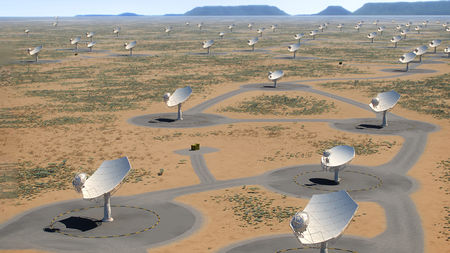Giant radio telescope array prepares to begin construction in Australia and South Africa – Science Magazine

An artist’s impression of the Square Kilometre Array’s radio dishes in southern Africa. It will add 133 dishes to the existing 64-dish MeerKAT array in South Africa.
SKA Organisation/Swinburne Astronomy Productions
Officials with the Square Kilometre Array (SKA), which will be the world’s biggest radio telescope, say they have nearly finalized designs and are planning for construction to begin in Australia and South Africa. This week, at a final engineering meeting in Shanghai, China, designs were presented for the array’s dishes and antennas, which a committee will review in the coming weeks—setting the stage for construction to begin.
“I’m feeling confident,” of starting construction in early 2021, says Philip Diamond, SKA director general at the organization’s headquarters near Manchester, U.K. The design review committee is expected to make suggestions, “but we’re not expecting any show-stoppers,” he says.
The SKA, funded by 13 nations from around the world, will eventually consist of thousands of dishes scattered across southern Africa and a million sticklike antennas in Western Australia. Daunting early cost estimates convinced planners to start with a more limited array that is expected to cost €1.7 billion for construction and 10 years of operation. In this first phase, the SKA group will deploy 130,000 antennas in Australia and add 133 dishes to the 64 of the MeerKAT array, an SKA precursor instrument in South Africa that opened last year.
In addition to contributions to the consortium, individual countries will be building their own facilities to use the data. The Chinese Academy of Sciences’s Shanghai Astronomical Observatory has had a team of researchers working on a big data center that will manipulate data initially processed in Australia and South Africa and then analyze it in cooperation with scientists worldwide, says Shen Zhiqiang, the observatory director. The SKA is going to produce “a huge amount of raw data,” that will be beyond current data transmission and handling capabilities, he says.
The two arrays “have distinct scientific cases,” says Douglas Bock, director of astronomy and space science for Australia’s Commonwealth Scientific and Industrial Research Organisation in Sydney. The low-frequency antennas observe radio emissions from pulsars—spinning neutron stars—and the epoch of reionization, when light from the universe’s first stars was ionizing the hydrogen in the space between galaxies. The dishes are tuned to observe at higher frequencies and could trace flows of hydrogen in star and galaxy formation. Observations with partial arrays could start in the mid-2020s.
If the review committee approves designs, the organization will next focus on getting member countries to ratify an SKA treaty that forms an international legal entity that can collect funding and award contracts. The Netherlands has already ratified. Bock says Australia is likely to ratify in January 2020. And China is expected to sign on in early spring, Shen says. Diamond says Italy, Portugal, South Africa, and the United Kingdom are expected to ratify by May 2020. The remaining six SKA members will join the treaty later.
The United States was initially involved but has since dropped out, at least officially. But many U.S. scientists and engineers are serving on the design review committee and contributing to the science plans, says Bryan Butler, a radio astronomer with the U.S. National Radio Astronomy Observatory (NRAO) in Socorro, New Mexico. Separately, U.S. astronomers are planning the Next Generation Very Large Array, which Butler says would rival the SKA in size and cost but observe at higher radio frequencies. The giant array would add dishes to NRAO’s Very Long Baseline Array and Very Large Array across Mexico and the U.S. Southwest. Backers are hoping to win approval for construction within 2 to 3 years. Butler expects the two groups to agree to share access to their instruments. “That is the path for U.S. participation in SKA,” Butler says.
*Correction, 26 November, 5:30 a.m.: An earlier version of the story incorrectly stated that the Shanghai Astronomical Observatory has been working on SKA antenna designs.






